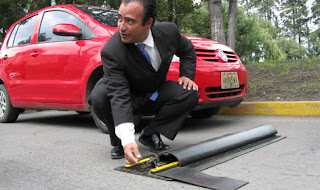Halloween Week Day #5: Haunted Houses
I think all of us, at one time or another, have felt like there was a mysterious presence in our homes. Maybe it was when we were little and heard noises coming from the closet. Or maybe it was when we spent our first night alone and could have sworn there were footsteps on the stairs. Or maybe it was when we stayed at an old farmhouse and saw strange shadows dancing across the walls...
Spooky noises or sights, especially at night, can come from a variety of non-ghost-related sources:
- Air trapped in a radiator can make a squealing or hissing noise.
- Changes in humidity can make the wood in the floorboards expand and contract creating squeaking sounds.
- Leaky windows can make curtains billow.
- Drafts moving through houses can sound like breathing or even swing doors on their hinges.
However, Canadian neuroscientist Michael Persinger believes that these effects are a result of actual "ghosts" based on his electromagnetic studies. He found fluctuating electromagnetic wave patterns in areas around the "haunted" properties. As far as I understand, there is theory that a person's conscious is contained in the electromagnetic field generated by their brain. Therefore, if a conscious ("thinking") spirit is moving through a space, the electromagnetic patterns in the room will shift with it.
Our friend Stephen James O’Meara has another explanation: "These [electromagnetic changes] could be due to anything from underground minerals or even solar activity such as fluctuations in sunspot activity." A person's temporal lobe (in their brain) can be sensitive to the small vibrations associated with these electromagnetic field fluctuations. It's so faint that one may not be consciously aware of the vibrations, but still feel that someone is moving around them. If the field is strong enough, it can also cause hallucinations!
O'Meara does admit, however, that both his and Persinger's explanations of these phenomena are theories, so I'll leave you to choose which to believe. In the words of O'Meara, "Until scientists find the answer, believers won't 'give up the ghost'!"
(to hear the interview that inspired many of this week's posts, please tune into the NPR podcast of 10.22.09's "Here and Now" at this link)
Have a safe and happy Halloween!





